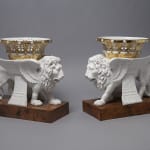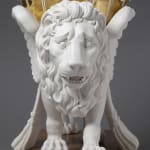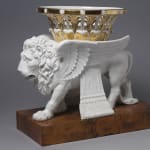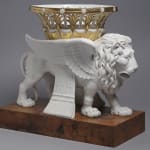



Pair Sèvres Biscuit models of Lions, Circa 1818-1820
Length: 151⁄8 ins. (38.5 cms.)
Further images
Pair Sèvres Biscuit models of Lions supporting gilt-white reticulated Baskets (Lions ‘canéphores’) after a model by Jean-Charles-Nicholas Brachard l’ainé, after a drawing by Fragonard.
One Lion incised AB and 10 Oct 18 No 2, it’s basket with Blue stencilled interlaced L’s enclosing a ‘Fleur-de-Lys’ and Sèvres Gilt 29 JUIN DG 19, incised AB. The other lion incised 3 Juillet-19, it’s basket with blue stencilled interlaced L’s mark, enclosing a ‘Fleur-de-Lys’ and Sèvres 20 and inscribed in Gilt 24 AL20, Incised CH.
Each lion modelled as a prowling lion with embroidered saddle cloth, it’s back fitted with a reticulated circular basket, on an original rectangular “tôle-peinte” base painted as faux-siena marble.
The present model of a pacing lion was conceived in 1817 as a pair with a lioness, designed by Alexandre-Evariste Fragonard to accompany Egyptian canephoric figures bearing baskets as part of an elaborate dessert service and to flank a central basket or corbeille canephore supported by four female figures.
Jean-Charles-Nicholas Brachard l’aine, employed at Sevres as a sculptor, translated Fragonard’s fantasy into three-dimensional reality two years later. It would appear that only the lion was ever made, never the lioness. Drawings of Fragonard’s project for both and a plaster of Brachard’s original model are retained by Sevres.
The first entry in the sales records for a ‘Lion Canephore’ is dated 1818 and notes 150 francs for the lion, 100 francs for the basket, and 40 francs for the tole-peinte base as the basis for the 290 franc selling price. Entering the saleroom 26 December 1818 and exhibited at the Louvre in January 1819, the ‘pair’ were delivered to Monsieur le chevalier de la Malle conseiller d’Etat Membre du comite du contentieux on 2 February 1820. The first of the present ‘pair’, incised with the same date as that of the payment record and with ‘No. 2’ is almost certainly one of these.
Given it’s gilding date of 24 April 1820, the second of the two present examples is likely to have been delivered to the ‘prefet’ M. Destouches 2 June 1820, oddly entered in the saleroom ledger on 1 July of that year. Further saleroom entries are dated 1823, 1845 and 1849. A single example is retained in the ministry of foreign affaires, see Tamara Preaud and Marcelle Brunet, Sevres des origines a nos jours, p. 291, no. 354.
Our thanks to Tamara Preaud for this information.
Exhibitions
New York, The Bard Graduate Centre for Studies in the Decorative Arts, The Sevres Porcelain Manufactory: Alexandre Brongniart and the Triumph of Art and Industry, 1800-1847, 17 October 1997-1 February 1998, cat. No. 143 a.b.Literature
Tamara Preaud, et al., The Sevres Porcelain Manufactory: Alexandre Brongniart and the Triumph of Art and Industry, 1800-1847, London, 1997, p.223, cat. No. 44 a.b. and p. 358, cat. No. 143 a.b.Join our mailing list
* denotes required fields
We will process the personal data you have supplied in accordance with our privacy policy (available on request). You can unsubscribe or change your preferences at any time by clicking the link in our emails.



